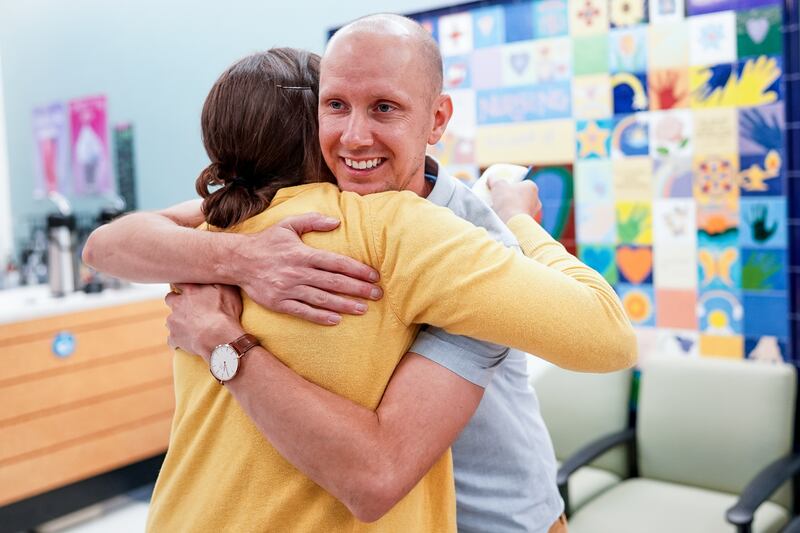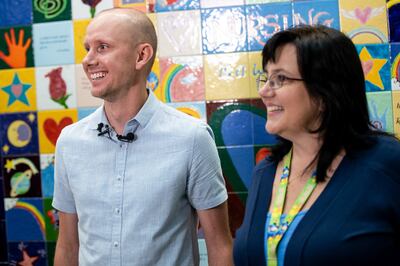SALT LAKE CITY — When 7-year-old Ian Dahl was diagnosed with cancer in 1994, his parents thought he was going to die.
They were given three options for treatment, none of them certain to work, recalls Hilary Saunders, a nurse practitioner at Intermountain Healthcare’s Primary Children’s Hospital oncology unit. For acute myeloid leukemia, the type of cancer Dahl had, she said, no one was sure what would happen.
“At that time, the success rate for treating AML was 20% or less, and that was generous, in my opinion,” Saunders said.

On Nov. 11 of that year, the young boy was given a bone marrow transplant using cells harvested from his dad, the closest available match at the time and Dahl’s only chance for survival.
“Not a day goes by when I don’t think, ‘None of this was really supposed to happen for me.’ ... My life, my kids, I really appreciate all the little things a lot more,” Dahl, 32, of Sandy, said Thursday during a celebration of 25 years of bone marrow transplants at Primary Children’s Hospital.
He was the hospital’s 17th bone marrow transplant, and the fourth who survived.
“It’s the start of a new you,” Saunders said about a patient who gets new bone marrow, where the blood cells are produced. The old marrow is deteriorated by the cancer and new marrow makes life possible. “It’s a whole new immune system so your body can fight. It gives you a new outlook on life,” she said.
“It gives you a chance to be healthy,” Dr. Michael Boyer, medical director of the pediatric blood and marrow transplant program at Primary Children’s Hospital, said Thursday. He said bone marrow transplant is “a tough treatment.”
In 25 years, doctors at Primary Children’s have performed more than 700 bone marrow transplants, including for cancer patients, but also certain blood-related disorders. The patients came to the hospital from 13 states and four countries.
Doctors have done 43 of the procedures this year, Boyer said.
Ten years ago, he said, bone marrow transplants were proven to cut the death rate in half for cancer patients.
“It has evolved a lot,” Boyer said.
Dahl doesn’t remember much about his lengthy stays in the hospital as a kid, but he will never forget the bad taste of the cyclosporine he was given to combat side effects of chemotherapy, the friendly hospital staff and all the activities he was able to do in the unit, as well as what it was like to be treated like he was “special.”
“Ian is all around, a very special patient,” Saunders said, because he was one of the first to undergo the procedure, but also because Dahl’s family has kept in touch with the doctors and nurses who worked to save his life.
“It’s been fun to see him grow up. I love seeing that Ian has children, which is another thing about him that is beyond amazing,” she said, adding that cancer treatments often preclude bearing children. “He has always held a special place in my heart.”
Dahl inherited an allergy to cats after the transplant, as his dad was allergic but Dahl wasn’t prior to the procedure. He sometimes has issues with eczema, akin to his dad. But looking at him, no one would know he survived cancer as a child, using bone marrow from a family member.

Dahl’s father has since joined the official Bone Marrow Registry, operated by the nonprofit National Marrow Donor Program, and has had the opportunity to donate his bone marrow multiple times. Dahl said the experience has enriched the lives of everyone in his family.
“It was a huge miracle for our family,” he said.
“It’s important that everybody register,” Saunders said. “It’s a beautiful thing to save the life of an adult or child.”
The “younger the better” when it comes to bone marrow donors, Boyer said, as there is less pain resulting from the procedure and a quicker recovery. However, donors of all ages are needed, as well as people from various ethnic backgrounds, specifically Hispanic, Asian or Native American, he said.
“Sometimes people are on the registry for years waiting to be called,” Boyers said. About one in 430 registrants end up donating to a patient, as they must meet age and health guidelines and be willing to donate to any patient in need. Donors between the ages of 18 and 44 are always needed.
At the time of Dahl’s procedure, the national registry was quite small. Finding a match was more difficult. His dad met five of six qualifications, whereas his mother and sister each met three of six — not enough to be viable.
Siblings, Boyer said, have a 1 in 4 chance of being a good match for transplantation, so the larger the registry, the better the odds are of finding a better match. Patients who share the same ancestry are most likely to match.
Be the Match, the world’s largest and most diverse registry, has nearly 35 million registrants. Healthy bone marrow, as it has for Dahl, can be the the cure for someone facing life-threatening disease.
All it takes to register as a bone marrow donor is a cotton swab collection of DNA from the mouth. A person can donate stem cells and/or marrow. For more information, visit bethematch.org.


